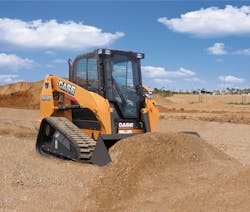Case Tier 4-Final Skid Steers, CTLs
Staying true to its legacy as an early adopter of SCR technology, Case Construction Equipment has introduced two Tier 4-Final skid steers (SR270 and SV300) and two Tier 4-Final compact track loaders (TR340, TV380) that use SCR to achieve T4F, as well as two skid steers (SR240, SV280) that use a particulate matter catalyst solution (no DPF) to meet regulations.
The SR270 and SV300 SSLs and the TR340 and TV380 CTLs are the industry’s first units in their product categories to use SCR technology. Case now has a line of nine skid steer loaders and four compact track loaders.
Weighing in at 8,117 and 8,655 pounds, respectively, the SR270 and SV300 SSLs deliver 282 lb.-ft. of torque and bucket breakout forces up to 8,776 pounds. Rated at 90 gross horsepower, the machines include standard (24.2 gpm) and high-flow auxiliary (37.6 gpm) hydraulics for attachment versatility. A 25.5-gallon fuel tank extends runtimes.
The radial-lift TR340 CTL weighs 10,000 pounds with a rated operating capacity (ROC) of 3,400 pounds and a bucket breakout force of 8,700 pounds. The vertical-lift TV380 CTL weighs 10,550 pounds, provides 7,510 pounds of bucket breakout force and an ROC of 3,800 pounds. Both machines are rated at 90 gross horsepower, produce 282 lb.-ft. of torque and feature increased hydraulic flow rates (standard: 24.2 gpm; high-flow: 37.6 gpm).
Rated at 74 horsepower, the large-frame SR240 and SV280 SSLs provide 232 lb.-ft. of torque and bucket breakout forces of up to 8,680 pounds. Weighing in at 7,400 pounds, the SR240 offers a ROC of 2,400 pounds, and the 8,090-pound SV280 has a ROC of 2,800 pounds.
Case says the Tier 4-Final solution on the SR240 and SV280 is entirely maintenance free, with no filters to maintain or fluids to add. The company’s particulate matter catalyst is a combination of a DOC and a high-efficiency flow-through filter. The DOC oxidizes the machine’s exhaust to create heat and manage emissions. The remaining particulate matter then passes through to the filter where it is slowed and burned.
